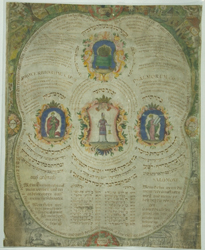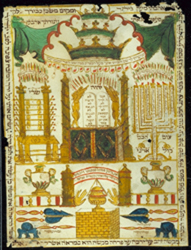
Keter (crown)
On vellum. Ca. 1800
The crown of the Torah, symbolizing learning, is frequently used as a motif in Jewish ceremonial art. The fourfold version of the crowns on this document represents the most important worldly attainments according to Pirke Avot (The Ethics of the Fathers, 4:17): the crown of Law (the figure of Moses on the right), the crown of royalty (the figure of David on the left), the crown of priesthood (the figure of Aaron in the center), and surpassing them all, the crown of a good name (on the throne above the three). Text in Hebrew, German, and Latin.
The decorations along the borders include the signs of the zodiac with scenes from daily life according to the seasons. The drawings on top, in color. depict summer and fall; the drawings on the bottom in black and white are of winter and spring.
This document probably was meant to be hung in a synagogue.

Keter (crown)
Place and date unknown
Symbolic representation of the three crowns: learning, priesthood, royalty. But surpassing them all is the fourth, the crown of a good name. To your left is a representation of the Tabernacle or the Temple with seven-branched candelabrum, the ark of the law, and the cherubim in the center. The shew-bread is on the left. The hands below represent the priesthood with an incense-holder.
This document, like the one above, was also probably meant to be hung in a synagogue.